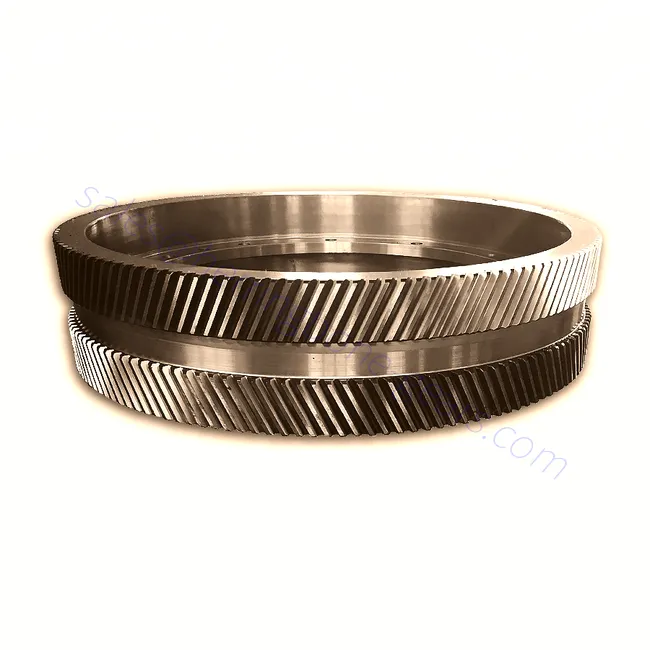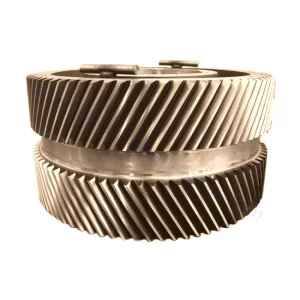Herringbone Gears
China Suppliers Carbon Steel Herringbone Helical gear
A herringbone gear, a specific type of double helical gear, is a side to side (not face to face) combination of two helical gears of opposite hands. Each helical groove of this gear looks like the letter V, and many together form a herringbone pattern (resembling the bones of a fish such as a herring). Unlike helical gears, herringbone gears do not produce an additional axial load.
Applications of Herringbone gear include transmission of high torque, heavy machinery, gas turbines, heavy-duty vehicles, torque gearboxes, etc. Apart from these, some of the other uses of these Herringbone gears include :
- The herringbone gears are used in the torque gearbox.
- Used in a steam turbine to marine propulsion.
- It is used in roller shafts in steel mills.
As one of the leading herringbone gears manufacturers, suppliers, and exporters of mechanical products, We offer herringbone gears and many other products.Please get in touch with us for details.
Mail:[email protected]
A Herringbone Gear is a custom gear, having a side-to-side combination of two helical gears of opposite hands. Unlike helical gears, they can sustain axial load with ease. The spiral grooves of this gear look like the letter V from an overhead view. Our herringbone gears are carefully made with the highest precision to handle the heaviest axial loads and transmit the highest amounts of power for your rich machinery applications.
Table: Difference between helical gear and herringbone gear
| Helical Gear | Herringbone Gear |
|---|---|
| The teeth of the helical gear are cut in a helix (either left-hand or right-hand helix) on the cylindrical gear blank. | Identical teeth are cut in two halves of the gear blank, maintaining the same module, several teeth, and helix angle but on the opposite hand of the helix. |
| A pair of mating helical gears produces significant radial thrust force. | The thrust force produces by each half of the gear is equal and opposite in direction, and thus they cancel out each other. |
| Radial thrust force limits the helix angle to a maximum of about 25°. | The absence of thrust force allows the use of a higher helix angle (up to about 45°). |
| Bearings that can handle both axial and thrust loads are required with helical gear. | Since thrust force does not exist, bearings that can handle heavy radial load can be used with herringbone gear. |
| The power transmission capability of helical gear is comparatively tiny. | It can transmit very high mechanical power or torque. |
| Design and manufacturing of helical gear are more accessible, and thus, it is cheap. | Herringbone gear is expensive because of its complicated design and manufacturing. |
Teeth profile: Teeth of the helical gear are cut in a helix on the pitch cylinder. A particular helical gear consists of either left-hand or correct hand helix teeth. At the time of engagement, a helical gear with a left-hand helix can only mate with a helical gear with a right-hand helix. On the other hand, a herringbone gear consists of both hands of the helix in a single gear unit. Each herringbone gear has two distinct halves—one half must have left-hand helix teeth, and the other should have correct hand helix teeth. Additional features such as pitch circle diameter, module, number of teeth, helix angle, and width or thickness will be identical in both the halves; the only difference is their hand of the helix.
Thrust force: Helical gear offers many benefits over spur gear, such as gradual loading on teeth, less vibration, more loading capacity, higher service life, etc. The main drawback is the thrust load. Since teeth of spur gear ate straight and parallelled to the gear axis, a pair of mating spur gears induces only radial load. Due to the spiral form of teeth, a couple of mating helical gears generate both radial and axial loads. Thus, more robust bearings are required to simultaneously sustain both types of load. Herringbone gear can offer similar benefits as the helical gear and, at the same time, eliminates the thrust force. Here thrust force produces by each halve is equal and opposite (because of the opposite hand of the helix), and thus the resultant thrust force becomes zero. So a pair of mating herringbone gears induces no axial thrust force on the bearings (only radial force exists).
Helix angle: Thrust force increases with the helix angle of the teeth; however, a higher helix angle can significantly reduce vibration and tooth wear and increase load-carrying capacity. This thrust force limits the maximum helix angle in the case of helical gear. Typically it is kept between 20 – 25°. However, the absence of thrust force in herringbone gear facilities uses of higher helix angle, even up to 45°.
Bearings for mounting the shafts: Driver and driven shafts are mounted at both ends using appropriate approaches. Besides supporting the beams and maintaining an accurate position, bearings also talk away from the vibration and load and transmit them to the ground via the frame. Typically, rolling contact bearings are employed in gear units unless they have a very high rotational speed. There are various types of rolling contact bearings. Some are suitable for radial load only, some are suitable for axial load only, and few can handle radial and thrust load. For example, deep groove ball bearings, angular contact bearings, and taper roller bearings can handle radial and thrust loads. Thus these bearings can be employed for helical gear units. On the other hand, cylindrical roller bearings can handle the heavy radial load and, therefore, be utilized with a herringbone gear unit.
Power transmission capacity: Basic function of every mechanical drive is to transmit mechanical power from the driving shaft to the driven shaft. Different industries offer varying levels of transmission capacity based on size, material, and other features. Although the transmission capacity of helical gear is comparatively higher than that of similar spur gear, it is generally not used for heavy-duty applications. The thrust load and availability of bearings impose the limit on heavy-duty applications. Herringbone gear and double helical gears are the preferred choices for such areas. For example, a herringbone planetary gear train (HPGT) can be observed in heavy machinery like coal cutters, aerospace engines, wind turbines, etc.
Gear fabrication: Cutting helical teeth on the cylindrical gear blank is not difficult; however, the problem arises when clearance does not exist at the end of teeth. Like spur gear, helical gear teeth can also be cut by a pinion-type gear shaping cutter. Hobbing can also be used for cutting helical gears. But in herringbone gear, no relief gap exists between the left and right halves. Thus cutting teeth at this junction is quite complicated as there exists a risk of overstepping to the other half. It requires a specialized hobbing cutter having a grove matching the herringbone gear. A high degree of locational and angular alignment is also necessary to maintain.




